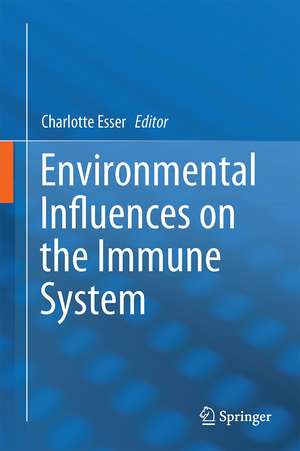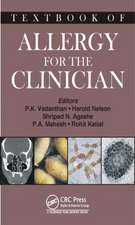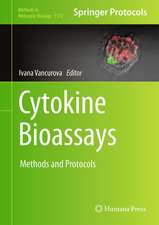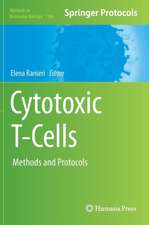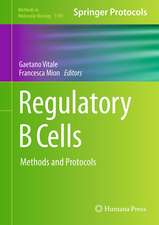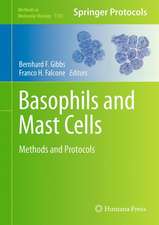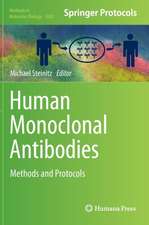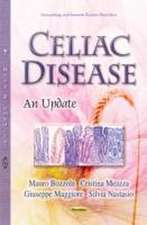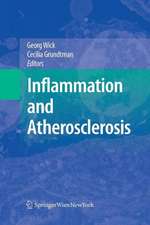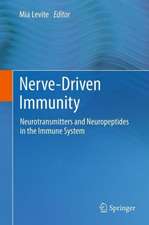Environmental Influences on the Immune System
Editat de Charlotte Esseren Limba Engleză Hardback – 24 feb 2016
The immune system is commonly assumed to respond to harmful pathogens such as bacteria and viruses. However, harmless bacteria, chemicals, stress, normal food and other factors can also trigger, shape or interfere with the immune system, often producing adverse effects. Yet, it is also becoming increasingly accepted that some of these interactions are physiological and necessary for a healthy immune system.
Examples of negative effects include the immunosuppressive effects of UV irradiation, or the immunotoxic effects of man-made chemicals such as polycyclic aromatic hydrocarbons. Autoimmunity or allergies can be the adverse consequences of interaction between the immune system and chemical compounds such as drugs. Positive effects can come from natural exposure levels to bacteria, healthy life-style or the diet.
There is a great need to understand how communication between the environment and the immune system works. This book addresses this need. It covers environmental factors (such as bacteria, sun exposure), human factors (such as age, exercise or stress), and important man-made factors (such as air pollution). A chapter on human rights complements the scientific chapters. The book is intended for immunologists, toxicologists and researchers who want to know how the immune system works and is triggered, as well as for medical doctors in environmental medicine and the general public interested in immunology.
| Toate formatele și edițiile | Preț | Express |
|---|---|---|
| Paperback (1) | 989.34 lei 39-44 zile | |
| SPRINGER VIENNA – 13 mar 2019 | 989.34 lei 39-44 zile | |
| Hardback (1) | 1114.19 lei 3-5 săpt. | |
| SPRINGER VIENNA – 24 feb 2016 | 1114.19 lei 3-5 săpt. |
Preț: 1114.19 lei
Preț vechi: 1172.83 lei
-5% Nou
Puncte Express: 1671
Preț estimativ în valută:
213.20€ • 223.05$ • 177.11£
213.20€ • 223.05$ • 177.11£
Carte disponibilă
Livrare economică 13-27 martie
Preluare comenzi: 021 569.72.76
Specificații
ISBN-13: 9783709118887
ISBN-10: 3709118883
Pagini: 378
Ilustrații: XIX, 378 p. 24 illus., 7 illus. in color.
Dimensiuni: 155 x 235 x 27 mm
Greutate: 0.91 kg
Ediția:1st ed. 2016
Editura: SPRINGER VIENNA
Colecția Springer
Locul publicării:Vienna, Austria
ISBN-10: 3709118883
Pagini: 378
Ilustrații: XIX, 378 p. 24 illus., 7 illus. in color.
Dimensiuni: 155 x 235 x 27 mm
Greutate: 0.91 kg
Ediția:1st ed. 2016
Editura: SPRINGER VIENNA
Colecția Springer
Locul publicării:Vienna, Austria
Public țintă
ResearchCuprins
Recenzii
Notă biografică
Charlotte Esser is Professor of Immunology and group leader at the Leibniz Research Institute for Environmental Medicine (IUF) in Düsseldorf, Germany. Her Research focuses on the adverse or beneficial consequences that low molecular weight substances (such as environmental toxins or dietary supplements) have on function and differentiation of the immune system in mice and men. A main focus lies on the analysis of the arylhydrocarbon receptor.
Textul de pe ultima copertă
This book bringstogether articles on the overarching theme of how the environment shapes theimmune system.
The immune system iscommonly assumed to respond to harmful pathogens such as bacteria andviruses. However, harmless bacteria, chemicals, stress, normal food and otherfactors can also trigger, shape or interfere with the immune system, often producing adverse effects. Yet, it is also becoming increasingly acceptedthat some of these interactions are physiological and necessary for a healthyimmune system.
Examples of negativeeffects include the immunosuppressive effects of UV irradiation, or theimmunotoxic effects of manmade chemicals such as polycyclicaromatic hydrocarbons. Autoimmunity or allergies can be the adverseconsequences of interaction between the immune system and chemical compounds such as drugs. Positiveeffects can come from natural exposure levels to bacteria, healthy life-styleor the diet.
There is a great needto understand how communication between the environment and the immune systemworks. This book addresses this need. It covers environmental factors (suchas bacteria, sun exposure), human factors (such as age, exercise or stress),and important man-made factors (such as air pollution). A chapter on humanrights complements the scientific chapters. The book is intended forimmunologists, toxicologists and researchers who want to know how the immune systemworks and is triggered, as well as for medical doctors in environmentalmedicine and the general public interested in immunology.
The immune system iscommonly assumed to respond to harmful pathogens such as bacteria andviruses. However, harmless bacteria, chemicals, stress, normal food and otherfactors can also trigger, shape or interfere with the immune system, often producing adverse effects. Yet, it is also becoming increasingly acceptedthat some of these interactions are physiological and necessary for a healthyimmune system.
Examples of negativeeffects include the immunosuppressive effects of UV irradiation, or theimmunotoxic effects of manmade chemicals such as polycyclicaromatic hydrocarbons. Autoimmunity or allergies can be the adverseconsequences of interaction between the immune system and chemical compounds such as drugs. Positiveeffects can come from natural exposure levels to bacteria, healthy life-styleor the diet.
There is a great needto understand how communication between the environment and the immune systemworks. This book addresses this need. It covers environmental factors (suchas bacteria, sun exposure), human factors (such as age, exercise or stress),and important man-made factors (such as air pollution). A chapter on humanrights complements the scientific chapters. The book is intended forimmunologists, toxicologists and researchers who want to know how the immune systemworks and is triggered, as well as for medical doctors in environmentalmedicine and the general public interested in immunology.
Caracteristici
A comprehensive work on the effect of the environment on the immune system
Unique book in this field on the market
Gives a basic overview of research models, mechanism and structures as well as a thorough insight into professional immunology
Unique book in this field on the market
Gives a basic overview of research models, mechanism and structures as well as a thorough insight into professional immunology
